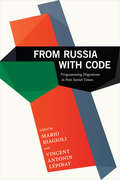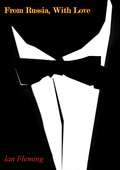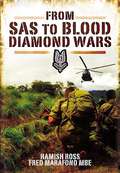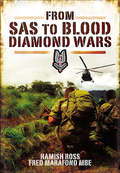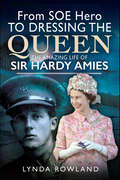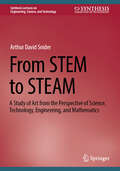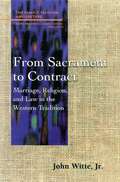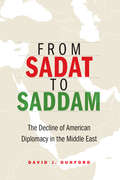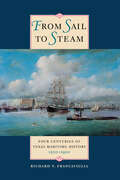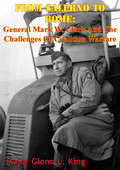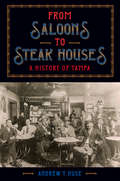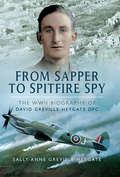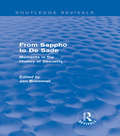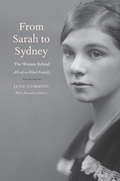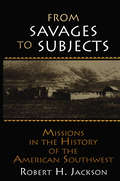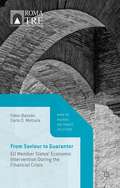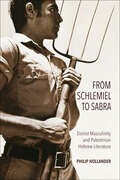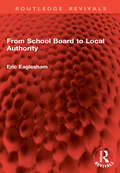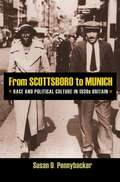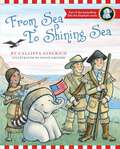- Table View
- List View
From Russia to the West: The Musical Memoirs and Reminiscences of Nathan Milstein
by Antonina W. Bouis Nathan Milstein Solomon Volkov1. Childhood in Odessa I was born in Odessa, a beautiful and gay city on the Black Sea, in the south of the Russian empire. I grew up a hellion. I would run outside, shout, fight with other kids, then save myself by running home. It wasn't very brave or risky on my part, but Mother worried about me anyway. A neighbor in our building, Mrs. Roisman, gave advice: "You have to keep Nathan busy! Let him take music lessons!"
From Russia with Code: Programming Migrations in Post-Soviet Times
by Mario Biagioli Vincent Antonin LépinayWhile Russian computer scientists are notorious for their interference in the 2016 US presidential election, they are ubiquitous on Wall Street and coveted by international IT firms and often perceive themselves as the present manifestation of the past glory of Soviet scientific prowess. Drawing on over three hundred in-depth interviews, the contributors to From Russia with Code trace the practices, education, careers, networks, migrations, and lives of Russian IT professionals at home and abroad, showing how they function as key figures in the tense political and ideological environment of technological innovation in post-Soviet Russia. Among other topics, they analyze coders' creation of both transnational communities and local networks of political activists; Moscow's use of IT funding to control peripheral regions; brain drain and the experiences of coders living abroad in the United Kingdom, United States, Israel, and Finland; and the possible meanings of Russian computing systems in a heterogeneous nation and industry. Highlighting the centrality of computer scientists to post-Soviet economic mobilization in Russia, the contributors offer new insights into the difficulties through which a new entrepreneurial culture emerges in a rapidly changing world. Contributors. Irina Antoschyuk, Mario Biagioli, Ksenia Ermoshina, Marina Fedorova, Andrey Indukaev, Alina Kontareva, Diana Kurkovsky, Vincent Lépinay, Alexandra Masalskaya, Daria Savchenko, Liubava Shatokhina, Alexandra Simonova, Ksenia Tatarchenko, Zinaida Vasilyeva, Dimitrii Zhikharevich
From Russia, With Love (Modern Classics Ser.)
by Ian FlemingMURDER ON THE ORIENT EXPRESSThe Russians wanted to liquidate James Bond—ace British secret agent—in a way that would embarrass England. So they lined up their best team to pull off the job!Tatiana Romanova—an alluring brunette seductress who looks like Garbo although her heart belongs to the State.Red Grant—a renegade Irish hired assassin, who likes to kill for kicks.Rosa Klebb—head of Otydel II, department of torture and death, a hideous woman with a lust for inflicting excruciating torment.The master conspirators devise a trap designed to eliminate Bond on a perilous journey from Istanbul to Paris via the lush Orient Express. A trip on which Bond makes passionate love to one of his captors as he fights desperately to protect his life from the others, while the train speeds towards its ultimate, awful rendezvous with death!JAMES BOND becomes the target of theRUSSIAN MURDER ORGANIZATION, SMERSH…The deadly and sinister SMERSH sets a trap to catch and kill James Bond, ace British spy with a weakness for women and wine, and they bait it with a beautiful brunette. But they don’t count on her falling in love with her victim…after she has seduced him!!“One of the most outrageously entertaining thrillers ever contrived.”—New York World Telegram and Sun.
From SAS to Blood Diamond Wars
by Hamish Ross Fred Marafono<p>On the point of being demobbed from the SAS, Fred Marafono was recruited by David Stirling for his private security company. After Stirling’s death, Fred found himself in the midst of Sierra Leone’s Blood Diamond wars, and formed an unbreakable bonding with the country’s champion of democracy, Chief Hinga Norman, whose leadership and tragic death are integral to the story. <p>Fred was recruited by Simon Mann for the finest of all private military companies in Africa, Executive Outcomes. Fewer than two hundred of them defeated the rebels in their strongholds. Through political weakness, Executive Outcomes were made to leave the country, and chaos ensued. Committed men like Hinga Norman and British High Commissioner Peter Penfold saw that in the absence of military commitment from the west, only high caliber mercenaries would win the fight to restore democracy: three of them kept a vital air bridge open − ‘What God abandoned, these defended’. Fred’s final action was supporting the SAS in their brilliant hostage release, ‘Operation Barras.’ <p>Peter Penfold sums it all up in the book’s foreword, writing of the, ‘confidence, trust and admiration I have for this remarkable man.’</p>
From SAS to Blood Diamond Wars
by Hamish Ross Fred MarafonoAlcibiades is one of the most famous (or infamous) characters of Classical Greece. A young Athenian aristocrat, he came to prominence during the Peloponnesian War (429-404 BC) between Sparta and Athens. Flamboyant, charismatic (and wealthy), this close associate of Socrates persuaded the Athenians to attempt to stand up to the Spartans on land as part of an alliance he was instrumental in bringing together. Although this led to defeat at the Battle of Mantinea in 418 BC, his prestige remained high. He was also a prime mover in Athens' next big strategic gambit, the Sicilian Expedition of 415 BC, for which he was elected as one of the leaders. Shortly after arrival in Sicily, however, he was recalled to face charges of sacrilege allegedly committed during his pre-expedition reveling. Jumping ship on the return journey, he defected to the Spartans.Alcibiades soon ingratiated himself with the Spartans, encouraging them to aid the Sicilians (ultimately resulting in the utter destruction of the Athenian expedition) and to keep year-round pressure on the Athenians. He then seems to have overstepped the bounds of hospitality by sleeping with the Spartan queen and was soon on the run again. He then played a devious and dangerous game of shifting loyalties between Sparta, Athens and Persia. He had a hand in engineering the overthrow of democracy at Athens in favor of an oligarchy, which allowed him to return from exile, though he then opposed the increasingly-extreme excesses of that regime. For a time he looked to have restored Athens' fortunes in the war, but went into exile again after being held responsible for the defeat of one of his subordinates in a naval battle. This time he took refuge with the Persians, but as they were now allied to the Spartans, the cuckolded King Agis of Sparta was able to arrange his assassination by Persian agents.There has been no full length biography of this colorful and important character for twenty years. Professor Rhodes brings the authority of an internationally recognized expert in the field, ensuring that this will be a truly significant addition to the literature on Classical Greece.
From SOE Hero to Dressing the Queen: The Amazing Life of Sir Hardy Amies
by Lynda RowlandThe biography of one of Britain’s foremost fashion designers who led a fascinating double life as a couturier and an intelligence officer during the Second World War. Sir Hardy Amies was one of Britain’s foremost fashion designers who led a fascinating double life as a couturier and an intelligence officer during the Second World War. Sir Hardy’s work for the Belgian resistance effort as part of the Special Operations Executive, was so significant that he was awarded l’Ordre de la Couronne, or Order of the Crown, by the Belgian Government in 1948. Not only did Sir Hardy conduct these operations, but he also simultaneously developed his burgeoning fashion business through the British Board of Trade’s drive to promote UK manufacturing throughout the conflict. He was a man who at once epitomized and challenged the reality of being gay in an era when society was deeply unaccepting. He was thrust into what was an overtly macho and potentially hostile environment and, against that backdrop, made a valuable and courageous contribution to the war effort. Born into what we would consider a lower middle-class family, he was handsome, cultured and gregarious and effortlessly traversed the post-war world of high society, launching his haute couture house to great acclaim, gaining clients ranging from film stars to royalty. His work for Queen Elizabeth II saw him awarded the CVO in 1977 and this was elevated to the KCVO, Knight Commander of the Victorian Order in 1989. Her Majesty’s warmth of feeling towards Sir Hardy is evident in the many hand-written thank-you letters she sent him over the course of their long working relationship. Sir Hardy, who lived until the age of 93, could have been dismissed as a lightweight character from the frivolous world of fashion. However, despite a not-particularly extensive formal education, he was highly intelligent, extremely well-traveled and spoke three languages, and his story encapsulates the extraordinary cultural and societal turbulence of the twentieth century.
From STEM to STEAM: A Study of Art from the Perspective of Science, Technology, Engineering, and Mathematics (Synthesis Lectures on Engineering, Science, and Technology)
by Arthur David SniderThis book provides readers with an introductory overview of art from the perspective of science, technology, engineering, and mathematics. The author utilizes well-known and important works of art to demonstrate how STEM concepts apply to them. The book’s examples include a structural analysis of Michelangelo’s David. The author covers major breakthroughs in art history, such as the discovery of perspective. The book also discusses other important elements of art, such as color, from a scientific point of view. The author ensures that readers will understand the art terms used by comparing them with terms used in STEM fields of study.
From Sacrament to Contract: Marriage, Religion, and Law in the Western Tradition
by John Witte Jr.In From Sacrament to Contract, John Witte Jr. offers a study of five conflicting models of marriage--Catholic, Lutheran, Calvinist, Anglican, and Enlightenment--and their social and political impact over the last thousand years. In so doing, Witte shows how we arrived at the notion of marriage as contract. The Family, Culture, and Religion series offers informed and responsible analyses of the state of the American family from a religious perspective and provides practical assistance for the family's revitalization.
From Sadat to Saddam: The Decline of American Diplomacy in the Middle East
by David J. DunfordFrom Sadat to Saddam offers a fresh perspective on the politicization of the U.S. diplomatic corps and the militarization of U.S. foreign policy in the Middle East. This book begins with the 1981 assassination of Egyptian president Anwar Sadat, continues through two Gulf wars, and ends with the U.S. withdrawal of combat troops from Iraq in 2011. This firsthand account of thirty years in the diplomatic trenches of U.S. foreign policy in the Middle East addresses the basic questions of how and why we find ourselves today in endless military conflict and argues that it is directly related to the decline in reliance on our diplomatic skills. From Sadat to Saddam offers an in-depth look by a career diplomat at how U.S. soft power has been allowed to atrophy. It chronicles three decades of dealing not just with foreign policy challenges and opportunities but also with the frustrations of working with bureaucrats and politicians who don&’t understand the world and are unwilling to listen to those who do. The book makes clear that the decline of our diplomatic capability began well before the election of Donald Trump. It recommends that instead of trying to make soldiers into diplomats and diplomats into soldiers, we invest in a truly professional diplomatic service.
From Sail to Steam: Four Centuries of Texas Maritime History, 1500–1900
by Richard V. FrancavigliaThe Gulf Coast has been a principal place of entry into Texas ever since Alonso Alvarez de Pineda explored these shores in 1519. Yet, nearly five hundred years later, the maritime history of Texas remains largely untold. In this book, Richard V. Francaviglia offers a comprehensive overview of Texas’ merchant and military marine history, drawn from his own extensive collection of maritime history materials, as well as from research in libraries and museums around the country. Based on recent discoveries in nautical archaeology, Francaviglia tells the stories of the Spanish flotilla that wrecked off Padre Island in 1554 and of La Salle’s flagship Belle, which sank in 1687. He explores the role of the Texas Navy in the Texas Revolution of 1835–1836 and during the years of the Texas Republic and also describes the Civil War battles at Galveston and Sabine Pass. Finally, he recounts major developments of the nineteenth century, concluding with the disastrous Galveston Hurricane in 1900. More than one hundred illustrations, many never before published, complement the text.
From Sail to Steam: Four Centuries of Texas Maritime History, 1500–1900
by Richard V. Francaviglia&“The story of the ships, mariners, and ports that formed a vital connection between Texas and the rest of the world . . . [A] &‘first-stop&’ reference.&” —The Journal of American History Second Place, Presidio La Bahia Award, Sons of the Republic of Texas The Gulf Coast has been a principal place of entry into Texas ever since Alonso Alvarez de Pineda explored these shores in 1519. Yet, nearly five hundred years later, the maritime history of Texas remains largely untold. In this book, Richard V. Francaviglia offers a comprehensive overview of Texas&’ merchant and military marine history, drawn from his own extensive collection of maritime history materials, as well as from research in libraries and museums around the country. Based on recent discoveries in nautical archaeology, Francaviglia tells the stories of the Spanish flotilla that wrecked off Padre Island in 1554 and of La Salle&’s flagship Belle, which sank in 1687. He explores the role of the Texas Navy in the Texas Revolution of 1835–1836 and during the years of the Texas Republic and also describes the Civil War battles at Galveston and Sabine Pass. Finally, he recounts major developments of the nineteenth century, concluding with the disastrous Galveston Hurricane in 1900. More than one hundred illustrations, many never before published, complement the text. &“Although there have been many excellent and valuable books published previously on specific topics in Texas&’ maritime development (e.g. the Texas Navy, river trade, the Civil War, etc.), we have been waiting a long time for a single volume that ties all those loose threads together into a single, cohesive whole.&” —Andrew W. Hall, specialist in Texas marine history and archaeology
From Salerno To Rome: General Mark W. Clark And The Challenges Of Coalition Warfare
by Major Glenn L. KingOn 9 September 1943 the United States Fifth Army landed at Salerno, commencing a lengthy and costly campaign that would transit the Italian Peninsula. Lieutenant General Mark W. Clark commanded this army. His many supporters, including Winston Churchill and General Dwight D. Eisenhower, considered him a brilliant staff officer and trainer. His detractors, including General George S. Patton, considered him overly ambitious and self serving. Clark had been promoted ahead of many senior and experienced officers, some of whom were now his subordinate commanders within the Fifth Army. His army would come under the jurisdiction of the Fifteenth Army Group, a combined American-British Headquarters commanded by General Harold Alexander, an Englishmen. Clark would command a number of foreign troops, including the British X Corps, the New Zealand Corps and the French Expeditionary Corps. Throughout this campaign, Clark would face the complexities of coalition command, tactical in nature but with strategic consequences. This thesis contends that the command arrangements within Fifteenth Army Group, together with biased perceptions, greatly influenced the decision making of General Clark, an accomplished staff officer yet inexperienced army commander.
From Saloons to Steak Houses: A History of Tampa
by Andrew T. HuseSince its early days as a boomtown on the Florida frontier, Tampa has had a lively history rich with commerce, cuisine, and working-class communities. In From Saloons to Steak Houses, Andrew Huse takes readers on a journey into historic bars, theaters, gambling halls, soup kitchens, clubs, and restaurants, telling the story of Tampa’s past through these fascinating social spaces—many of which can’t be found in official histories. Beginning with the founding of modern Tampa in 1887 and spanning a century, Huse delves into the culture of the city and traces the struggles that have played out in public spaces. He describes temperance advocates who crusaded against saloons and breweries, cigar workers on strike who depended on soup houses for survival, and civil rights activists who staged sit-ins at lunch counters. These stories are set amid themes such as the emergence of Tampa’s criminal underworld, the rise of anti-German fear during World War I, and the heady power of prosperity and tourism in the 1950s. Huse draws from local newspaper stories and firsthand accounts to show what authorities and city residents saw and believed about these establishments and the people who frequented them. This unique take on Tampa history reveals a spirited city at work and play, an important cultural hub that continues to both celebrate and come to terms with its many legacies.
From Sand and Ash
by Amy HarmonItaly, 1943-Germany occupies much of the country, placing the Jewish population in grave danger during World War II. As children, Eva Rosselli and Angelo Bianco were raised like family but divided by circumstance and religion. As the years go by, the two find themselves falling in love. But the church calls to Angelo and, despite his deep feelings for Eva, he chooses the priesthood. Now, more than a decade later, Angelo is a Catholic priest and Eva is a woman with nowhere to turn. With the Gestapo closing in, Angelo hides Eva within the walls of a convent, where Eva discovers she is just one of many Jews being sheltered by the Catholic Church. But Eva can't quietly hide, waiting for deliverance, while Angelo risks everything to keep her safe. With the world at war and so many in need, Angelo and Eva face trial after trial, choice after agonizing choice, until fate and fortune finally collide, leaving them with the most difficult decision of all.
From Sapper to Spitfire Spy: The WWII Biography of David Greville-Heygate DFC
by Sally-Anne Greville HeygateDavid Greville-Heygate was one of the few men who served in both the army and the Royal Air Force during the Second World War, but it was in the sky that he really earned his stripes. Stalking the skies flying photo-reconnaissance missions with No. 16 Squadron over Northern France, he was to win the illustrious and highly coveted Distinguished Flying Cross (DFC). Another highlight saw him in action in the skies above the French coastline in preparation for the D-Day landings, taking photographs that would provide the allies with essential intelligence upon which to base their plans. Based in Holland in December 1944, David flew armed recces with No.168 Squadron then transferred to No.2 Squadron where he reported on troop movements behind German lines. During the course of a dynamic and eventful career, he flew a wide variety of iconic wartime aircraft including Lysanders, Mustangs, Typhoons and Spitfires in England, the Netherlands and Germany.Although there have been many stories about the Battle of Britain there has been less published about the life of a photo reconnaissance pilot during this time. David's thrilling exploits in the sky and the part he played within the context of the wider war are enlivened here to great effect by his daughter, Sally-Anne Greville Heygate, herself a professional photographer. Using snippets from diary entries, letters, logbooks, squadron records and other documents, she has managed to construct an engaging history of a talented photo-reconnaissance pilot and the war in which he fought.
From Sappho to De Sade: Moments in the History of Sexuality (Routledge Revivals)
by Jan BremmerThe history of sexuality has been the subject of increased interest in recent years and more widely acknowledged importance in the interpretation of past mentalités. Yet historians have only recently begun to study sexual practices in any depth, establishing that sexuality is not a biological constant but an ever-changing phenomenon, continuously shaped by people themselves. The contributors to this inter-disciplinary collection bring their expertise in ancient as well as medieval history, anthropology, modern history, and psychology to bear upon the history of sexuality. They explore various aspects of sexuality in successive periods: pederasty and lesbian love in antiquity, incest in the Middle Ages, sexual education during the Dutch Republic, voyeurism in the rococo, prostitution in Vienna around 1900, and the invention of sexology. From Sappho to De Sade, first published in 1989, offers an informative and entertaining collection of essays for students of cultural anthropology, social history and gender studies.
From Sarah to Sydney: The Woman Behind All-of-a-Kind Family
by June Cummins Alexandra DunietzThe untold life story of All-of-a-Kind Family author Sydney Taylor, highlighting her dramatic influence on American children&’s literature"Delv[es] deeply into historical context, including Jewish immigrant experiences. . . . An uncommonly intimate portrait. . . . Deeply empathetic."—Elissa Gershowitz, Horn Book This is the first and only biography of Sydney Taylor (1904–1978), author of the award-winning All-of-a-Kind Family series of books, the first juvenile novels published by a mainstream publisher to feature Jewish children characters. The family—based on Taylor&’s own as a child—includes five sisters, each two years apart, dressed alike by their fastidious immigrant mother so they all look the same: all-of-a-kind. The four other sisters&’ names were the same in the books as in their real lives; only the real-life Sarah changed hers to the boyish Sydney while she was in high school. Cummins elucidates the deep connections between the progressive Taylor&’s books and American Jewish experiences, arguing that Taylor was deeply influential in the development of national Jewish identity. This biography conveys the vital importance of children&’s books in the transmission of Jewish culture and the preservation of ethnic heritage.
From Savages to Subjects: Missions in the History of the American Southwest (Latin American Realities Ser.)
by Robert H. JacksonIncorporating recent findings by leading Southwest scholars as well as original research, this book takes a fresh new look at the history of Spanish missions in northern Mexico/the American Southwest during the 17th and 18th centuries. Far from a record of heroic missionaries, steadfast soldiers, and colonial administrators, it examines the experiences of the natives brought to live on the missions, and the ways in which the mission program attempted to change just about every aspect of indigenous life. Emphasizing the effect of the missions on native populations, demographic patterns, economics, and socio-cultural change, this path-breaking work fills a major gap in the history of the Southwest.
From Saviour to Guarantor: EU Member States' Economic Intervention During the Financial Crisis (ROMA TRE Business And Finance Collection)
by Fabio Bassan Carlo D. MotturaFrom Saviour to Guarantor.
From Schlemiel to Sabra: Zionist Masculinity and Palestinian Hebrew Literature (Perspectives On Israel Studies)
by Philip Hollander“Convincingly demonstrates the role of gender and sexuality in forming the Israeli state and . . . the place of literature as a force in politics.” —ChoiceIn From Schlemiel to Sabra, Philip Hollander examines how masculine ideals and images of the New Hebrew man shaped the Israeli state. In this innovative book, Hollander uncovers the complex relationship that Jews had with masculinity, interrogating narratives depicting masculinity in the new state as a transition from weak, feminized schlemiels to robust, muscular, and rugged Israelis. Turning to key literary texts by S.Y. Agnon, Y.H. Brenner, L.A. Arieli, and Aharon Reuveni, Hollander reveals how gender and sexuality were intertwined to promote a specific Zionist political agenda.A Zionist masculinity grounded in military prowess could not only protect the new state but also ensure its procreative needs and future. Self-awareness, physical power, fierce loyalty to the state and devotion to the land, humility, and nurture of the young were essential qualities that needed to be cultivated in migrants to the state. By turning to the early literature of Zionist Palestine, Hollander shows how Jews strove to construct a better Jewish future.
From Schlemiel to Sabra: Zionist Masculinity and Palestinian Hebrew Literature (Perspectives On Israel Studies)
by Philip Hollander“Convincingly demonstrates the role of gender and sexuality in forming the Israeli state and . . . the place of literature as a force in politics.” —ChoiceIn From Schlemiel to Sabra, Philip Hollander examines how masculine ideals and images of the New Hebrew man shaped the Israeli state. In this innovative book, Hollander uncovers the complex relationship that Jews had with masculinity, interrogating narratives depicting masculinity in the new state as a transition from weak, feminized schlemiels to robust, muscular, and rugged Israelis. Turning to key literary texts by S.Y. Agnon, Y.H. Brenner, L.A. Arieli, and Aharon Reuveni, Hollander reveals how gender and sexuality were intertwined to promote a specific Zionist political agenda.A Zionist masculinity grounded in military prowess could not only protect the new state but also ensure its procreative needs and future. Self-awareness, physical power, fierce loyalty to the state and devotion to the land, humility, and nurture of the young were essential qualities that needed to be cultivated in migrants to the state. By turning to the early literature of Zionist Palestine, Hollander shows how Jews strove to construct a better Jewish future.
From School Board to Local Authority (Routledge Revivals)
by Eric EagleshamFirst published in 1956, From School Board to Local Authority is a meticulous and exact inquiry into the events which led up to the famous Cockerton v. The School Board for London case. It suggests that the reorganization of the education system in 1902 was not primarily the result of an unexpected legal decision in 'Cockerton Judgement' rather was the outcome of a deliberate policy evolved by Morant and Gorst aimed at ending the administrative confusion which then existed. The book is based mainly on the material found on the files of the Education Department, the Science and Art Department, and the Local Government Board. It further reveals the administrative confusion and jealousies of these Departments, shown as conflicts about Higher Grade Schools, Secondary Schools, Organized Science Schools, and Evening Schools.
From Scottsboro to Munich: Race and Political Culture in 1930s Britain
by Susan D. PennybackerPresenting a portrait of engaged, activist lives in the 1930s, From Scottsboro to Munich follows a global network of individuals and organizations that posed challenges to the racism and colonialism of the era. Susan Pennybacker positions race at the center of the British, imperial, and transatlantic political culture of the 1930s--from Jim Crow, to imperial London, to the events leading to the Munich Crisis--offering a provocative new understanding of the conflicts, politics, and solidarities of the years leading to World War II. Pennybacker examines the British Scottsboro defense campaign, inaugurated after nine young African Americans were unjustly charged with raping two white women in Alabama in 1931. She explores the visit to Britain of Ada Wright, the mother of two of the defendants. Pennybacker also considers British responses to the Meerut Conspiracy Trial in India, the role that antislavery and refugee politics played in attempts to appease Hitler at Munich, and the work of key figures like Trinidadian George Padmore in opposing Jim Crow and anti-Semitism. Pennybacker uses a wide variety of archival materials drawn from Russian Comintern, Dutch, French, British, and American collections. Literary and biographical sources are complemented by rich photographic images. From Scottsboro to Munich sheds new light on the racial debates of the 1930s, the lives and achievements of committed activists and their supporters, and the political challenges that arose in the postwar years.Some images inside the book are unavailable due to digital copyright restrictions.
From Sea to Shining Sea
by Louis E. Wilson Christopher L. Salter Franklin Ng Gary B. Nash J. Jorge Klor de Alva Jacqueline M. Cordova Beverly J. Armento Karen K. WixsonYou're about to start an exciting journey around the world. You'll make this journey across maps and globes. The journey will first take you across the United States.
From Sea to Shining Sea
by Callista Gingrich Susan ArcieroEllis the Elephant is back and ready for another adventure in American history! In From Sea to Shining Sea, the fourth installment of Callista Gingrich’s New York Times bestselling series, Ellis explores the early years of the United States and heads west into uncharted territory with Lewis and Clark.In previous books, Sweet Land of Liberty, Land of the Pilgrims’ Pride, and Yankee Doodle Dandy, Ellis learned about pivotal moments that have shaped America. Now, in From Sea to Shining Sea, America’s favorite time-traveling pachyderm discovers a new and growing nation along with George Washington, Thomas Jefferson, Lewis and Clark, Sacagawea and others.Authored by Callista Gingrich and illustrated by Susan Arciero, From Sea to Shining Sea will delight those who want to know how brave Americans forged a growing nation and spread freedom from coast to coast.

